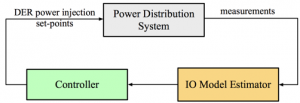A data-driven framework for coordinating the response of DERs to Provide Grid Support Services
Hanchen Xu with advisor P.Sauer and A.Dominguez-Garcia
Extensive research in developing DER coordination schemes for active and reactive power control could lead to effective frequency and voltage regulation — if there were accurate system models. Given that up-to-date operating conditions and system topology are usually unavailable, DER coordination schemes, robust against model errors, are yet to be investigated. However, deploying advanced meters and communications makes it possible to access more detailed operating states of power distribution systems. Using system-operating state measurements, we have developed a general data-driven DER coordination framework for grid support without explicitly relying on a system model.
The proposed framework, as illustrated in Figure 3, comprises three components: (i) a system model describing relations between the variables of interest, i.e., DERs active and/or reactive power injections, and the outputs of interest, including voltage magnitudes; (ii) an estimator giving estimates of the parameters that populate the model in (i); and (iii), a controller using the model in (i) with the parameters estimated via (ii) to determine the active and/or reactive power-injection DERs set points. A linear time-varying (LTV) IO model is adopted as the system model to capture the intrinsically nonlinear relation between the DERs active and/or reactive power injections (inputs) and the outputs of interest. The coefficients of the LTV IO model are essentially the output sensitivities with respect to active and/or reactive power injections. Model parameters are estimated by the estimator via the solution of a least-squares regression problem. The controller then uses the estimated parameter to update the DERs active and/or reactive power injections via the solution of another optimization problem.
We applied the proposed framework for coordinating DERs to provide frequency and voltage regulation. In frequency regulation, active power flows on the tie lines must track some signal (regulation power) sent by the bulk grid operator. Figure 4 shows the simulation results when the data-driven framework is applied to coordinate DERs for frequency regulation in the IEEE 33-bus distribution test feeder. Estimator accuracy is shown in Figure 4a, where the labels measurement, model, and actual indicate estimates obtained via the data-driven and model-based approaches, and the actual values, respectively. Obviously, the data-driven approach gives more accurate estimates of model parameters, LF, than the model-based one. Using the estimated model, the DERs can track the requested regulation power accurately, as shown in Figure 4b. In voltage regulation, voltage magnitudes at all buses must stay close to the reference level or within some range, for example, [0.95, 1.05] p.u. Figure 5 gives simulation results when the DER coordination framework is applied to provide voltage regulation in the IEEE 37-bus distribution test feeder. As shown in Figures 5a and b, the estimated model parameters x are very close to their true values, and the voltage magnitudes can be maintained within the pre-specified range, even when the system parameters change at time 60, as shown in Figure 5b. This research is supported by SBC University of Tennessee.


